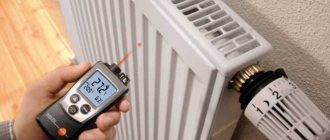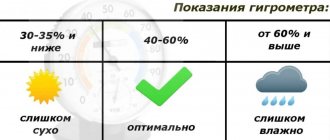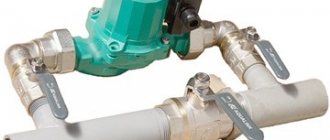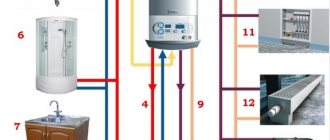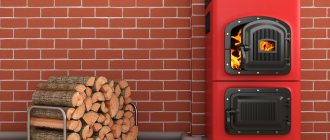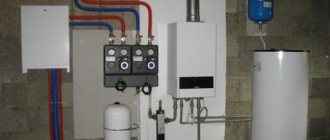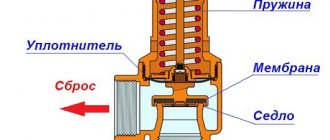What causes the pressure difference in heating and water supply systems? What is it for? How to regulate the difference? For what reasons does the pressure drop in the heating system? In this article we will try to answer these questions.
Thermal unit of the house. Its operation is impossible without the pressure difference between the threads of the heating main.
Functions
First, let's find out why the difference is created. Its main function is to ensure coolant circulation. Water will always move from a point with more pressure to a point with less pressure. The greater the difference, the greater the speed.
Useful: the limiting factor is the hydraulic resistance that increases with increasing flow velocity.
In addition, a difference is artificially created between the circulation connections of hot water supply into one thread (supply or return).
Circulation in this case performs two functions:
- Provides a consistently high temperature for heated towel rails , which in all modern houses open one of the hot water supply risers connected in pairs.
- Guarantees a quick supply of hot water to the mixer, regardless of the time of day and water supply through the riser. In old houses without circulation taps, the water has to be drained for a long time in the morning before it is heated.
Finally, the difference is created by modern water and heat consumption meters.
Electronic heat meter.
How and why? To answer this question, the reader must be referred to Bernoulli's law, according to which the static pressure of a flow is inversely proportional to the speed of its movement.
This gives us the opportunity to design a device that records water flow without the use of unreliable impellers:
- We pass the flow through the section transition.
- We record the pressure in the narrow part of the meter and in the main pipe.
Knowing the pressures and diameters, using electronics it is possible to calculate in real time the flow rate and water consumption; when using temperature sensors at the inlet and outlet of the heating circuit, it is easy to calculate the amount of heat remaining in the heating system. At the same time, the consumption of hot water is calculated based on the difference in flow rates in the supply and return pipelines.
Heating system
Why do you need an expansion tank?
The heating expansion tank stores excess expanded coolant when it is heated. Without an expansion tank, the pressure may exceed the tensile strength of the pipe. The tank consists of a steel barrel and a rubber membrane that separates air from water.
Air, unlike liquids, is highly compressible; with an increase in coolant volume by 5%, the pressure in the circuit due to the air tank will increase slightly.
The volume of the tank is usually taken approximately equal to 10% of the total volume of the heating system. The price of this device is low, so the purchase will not be ruinous.
The correct installation of the tank is with the hose facing up. Then excess air will not get into it.
Why does pressure decrease in a closed circuit?
Why does pressure drop in a closed heating system?
After all, the water has nowhere to go!
- If there are automatic air vents in the system, the air dissolved in the water at the time of filling will escape through them. Yes, it makes up a small part of the coolant volume; but a large change in volume is not necessary for the pressure gauge to register the change.
- Plastic and metal-plastic pipes may be slightly deformed under the influence of pressure. Combined with high water temperature, this process will speed up.
- The pressure in the heating system drops when the temperature of the coolant decreases. Thermal expansion, remember?
- Finally, minor leaks are easy to see only in centralized heating through rust marks. Water in a closed circuit is not so rich in iron, and the pipes in a private house are most often not made of steel; therefore, it is almost impossible to see traces of small leaks if the water has time to evaporate.
Why is a pressure drop in a closed circuit dangerous?
Boiler failure. In older models without thermal control - up to an explosion. Modern older models often have automatic control of not only temperature, but also pressure: when it falls below a threshold value, the boiler reports a problem.
In any case, it is better to maintain the pressure in the circuit at a level of approximately one and a half atmospheres.
Consequences of a heating boiler explosion.
How to slow down the pressure drop
In order not to recharge the heating system over and over again every day, a simple measure will help: install a second expansion tank of a larger volume.
The internal volumes of several tanks are summed up; the greater the total amount of air in them, the smaller the pressure drop will cause a decrease in the volume of coolant by, say, 10 milliliters per day.
Several expansion tanks can be connected in parallel.
Where to put the expansion tank
In general, there is no big difference for a membrane tank: it can be connected in any part of the circuit. Manufacturers, however, recommend connecting it where the water flow is as close to laminar as possible. If there is a heating circulation pump in the system, the tank can be mounted on a straight section of pipe in front of it.
Creating a drop
How is pressure difference created?
Elevator
The main element of the heating system of an apartment building is the elevator unit. Its heart is the elevator itself - a nondescript cast-iron tube with three flanges and a nozzle inside. Before explaining the principle of operation of the elevator, it is worth mentioning one of the problems of central heating.
There is such a thing as a temperature graph - a table of the dependence of the temperatures of the supply and return routes on weather conditions. Let's give a short excerpt from it.
| Outside air temperature, C | Feed, C | Return, C |
| +5 | 65 | 42,55 |
| 0 | 66,39 | 40,99 |
| -5 | 65,6 | 51,6 |
| -10 | 76,62 | 48,57 |
| -15 | 96,55 | 52,11 |
| -20 | 106,31 | 55,52 |
Deviations from the schedule up and down are equally undesirable. In the first case, it will be cold in the apartments, in the second, energy costs at the thermal power plant or boiler house will increase sharply.
A window open in cold weather means increased costs for energy workers.
At the same time, as is easy to see, the spread between the supply and return pipelines is quite large. With circulation slow enough for such a temperature delta, the temperature of the heating devices will be unevenly distributed. Residents of apartments whose radiators are connected to the supply risers will suffer from the heat, and owners of return radiators will freeze.
The elevator provides partial recirculation of the coolant from the return pipeline. By injecting a fast stream of hot water through the nozzle, in full compliance with Bernoulli's law, it creates a fast flow with low static pressure, which draws additional mass of water through the suction.
The temperature of the mixture is noticeably lower than that of the supply and slightly higher than that of the return pipeline. The circulation speed is high, and the temperature difference between the batteries is minimal.
Elevator operation diagram.
Support washer
This simple device is a steel disk at least a millimeter thick with a hole drilled in it. It is placed on the flange of the elevator unit between the circulation taps. Washers are placed on both the supply and return pipelines.
Important: for normal operation of the elevator unit, the diameter of the holes in the retaining washers must be larger than the diameter of the nozzle. Usually the difference is 1-2 millimeters.
Circulation pump
In autonomous heating systems, the pressure is created by one or more (according to the number of independent circuits) circulation pumps. The most common devices - with a wet rotor - are a design with a common shaft for the impeller and the rotor of the electric motor. The coolant performs the functions of cooling and lubricating the bearings.
Circulation pump with wet rotor.
How to create and add pressure to a heating system
To create or add pressure in a heating system, several methods are used.
Crimping
Pressure testing is the process of initially filling the heating system with coolant, temporarily creating a pressure that exceeds the operating pressure.
Attention! For new systems, during commissioning, the pressure should be 2-3 times higher than normal, and during routine checks, an increase of 20-40% is sufficient.
This operation can be performed in two ways:
- Connecting the heating circuit to the water supply pipeline and gradually filling the system to the required values , controlled by a pressure gauge. This method will not work if the pressure in the water supply is not high enough.
- Use of manual or electric pumps. When there is already coolant in the circuit, but there is not enough pressure, special pressure testing pumps are used. Liquid is poured into the pump reservoir, and the pressure is brought to the required level.
Photo 1. The process of crimping the heating system. In this case, a manual pressure test pump is used.
Checking the heating main for tightness and leaks
The main purpose of pressure testing is to identify faulty elements of the heating system in the maximum operating mode in order to avoid accidents during further operation. Therefore, the next step after this procedure is to check all elements for leaks. Tightness control is carried out by the pressure drop over a certain time after pressure testing. The operation consists of two stages:
- Cold test , during which the circuit is filled with cold water. Within half an hour, the pressure level should not drop by more than 0.06 MPa. In 120 minutes the drop should be no more than 0.02 MPa.
- Hot check , the same procedure is carried out, only with hot water.
Based on the results of the fall, a conclusion is made about the tightness of the heating system . If the test is passed, the pressure level in the pipeline is reset to operating values by removing excess coolant.
Values
What is the pressure difference between different sections of the heating system?
- Between the supply and return lines of the heating main it is approximately 20 - 30 meters, or 2 - 3 kgf/cm2.
Reference: excess pressure of one atmosphere raises the water column to a height of 10 meters.
- The difference between the mixture after the elevator and the return pipeline is only 2 meters, or 0.2 kgf/cm2.
- The difference on the retaining washer between the circulation taps of the elevator unit rarely exceeds 1 meter.
- The pressure created by a circulation pump with a wet rotor usually varies from 2 to 6 meters (0.2 - 0.6 kgf/cm2).
This pump creates a pressure of 3, 5 and 6 meters depending on the selected mode.
Adjustment
How to adjust the pressure in the elevator unit?
Support washer
To be precise, in the case of a retaining washer, it is not necessary to adjust the pressure, but to periodically replace the washer with a similar one due to abrasive wear of a thin steel sheet in process water. How to replace the washer with your own hands?
The instructions are generally quite simple:
- All gates or valves in the elevator are closed.
- One drain valve is opened on the return and supply to drain the unit.
- The bolts on the flange are loosened.
- Instead of the old washer, a new one is installed, equipped with a pair of gaskets - one on each side.
Tip: in the absence of paronite, washers are cut from an old car inner tube. Don't forget to cut an eyelet that will allow the washer to fit into the flange groove.
- The bolts are tightened in pairs, crosswise. After the gaskets are pressed, the nuts are tightened until they stop, no more than half a turn at a time. If you rush, uneven compression will sooner or later lead to the gasket being torn out by the pressure on one side of the flange.
Heating system
The difference between the mixture and the return flow is normally regulated only by replacing, welding or drilling out the nozzle. However, sometimes it becomes necessary to remove the difference without stopping the heating (usually in case of serious deviations from the temperature schedule during the peak of cold weather).
This is done by adjusting the inlet valve on the return pipeline; Thus, we remove the difference between the forward and reverse threads and, accordingly, between the mixture and the return.
For adjustment, use the lower valve number 1.
- We measure the supply pressure after the inlet valve.
- Switch the hot water supply to the supply thread.
- We screw the pressure gauge into the vent on the return line.
- We completely close the input check valve and then gradually open it until the difference decreases from the original by 0.2 kgf/cm2. Manipulation with the closing and subsequent opening of the valve is necessary to ensure that its cheeks are lowered as much as possible on the stem. If you simply close the valve, the cheeks may sag in the future; the price of ridiculous time savings is at least defrosted access heating.
- The return pipe temperature is monitored at daily intervals. If it is necessary to further reduce it, the difference is removed 0.2 atmospheres at a time.
DHW
What pressure should be in the heating system - we figured it out.
What will the pressure gauge show in the DHW system?
- When heating cold water with a boiler or flow-through heater, the pressure of warm water will be exactly equal to the pressure in the cold water main minus the losses to overcome the hydraulic resistance of the pipes.
- When supplying DHW from the return pipeline of the elevator in front of the mixer, there will be the same 3-4 atmospheres as on the return line.
- But when connecting DHW from the supply, the pressure in the mixer hoses can be about an impressive 6-7 kgf/cm2.
Practical consequence: when installing a kitchen faucet with your own hands, it is better not to be lazy and install several valves in front of the hoses. Their price starts from one and a half hundred rubles per piece. This simple instruction will give you the opportunity to quickly turn off the water if the hoses break and not suffer from its complete absence in the entire apartment during the renovation.
Pressure in the autonomous circuit
The immediate meaning of the word “difference” is a change in level, a fall. In the article we will touch on it too. So, why does the pressure drop in the heating system if it is a closed loop?
First, let's remember: water is practically incompressible.
Excessive pressure in the circuit is created due to two factors:
- The presence in the system of a membrane expansion tank with its air cushion.
The device of the membrane expansion tank.
- Elasticity of pipes and heating radiators. Their elasticity tends to zero, but with a significant area of the inner surface of the circuit, this factor also affects the internal pressure.
From a practical point of view, this means that the pressure drop in the heating system recorded by the pressure gauge is usually caused by an extremely slight change in the volume of the circuit or a decrease in the amount of coolant.
Here's a possible list of both:
- When heated, polypropylene expands more than water. When starting a heating system assembled from polypropylene, the pressure in it may drop slightly.
- Many materials (including aluminum) are sufficiently plastic to change shape under prolonged exposure to moderate pressure. Aluminum radiators can simply swell over time.
- Gases dissolved in water gradually leave the circuit through the air vent, affecting the actual volume of water in it.
- Significant heating of the coolant when the volume of the heating expansion tank is too low can trigger the safety valve.
Finally, very real malfunctions cannot be ruled out: minor leaks at the joints of sections and welding seams, etching nipple of the expansion tank and microcracks in the boiler heat exchanger.
The photo shows an intersectional leak on a cast iron radiator. Often it can only be noticed by traces of rust.
Pressure drop value for heating system
For the normal functioning of the heat supply, a certain pressure difference is required (the difference between the supply and return values of the coolant).
Typically, pressure loss in a heating system is 0.1-0.2 MPa. When this indicator is less, this is a signal of a disruption in the movement of water through the pipelines, which is accompanied by ineffective heating (the coolant passes through the radiators without heating them to the required value). When the differential value is exceeded by more than 0.2 MPa, “stagnation” of the system begins, resulting from airing.
A sharp change in pressure does not have the best effect on the functioning of individual elements of the heating structure, often causing their breakdowns.
